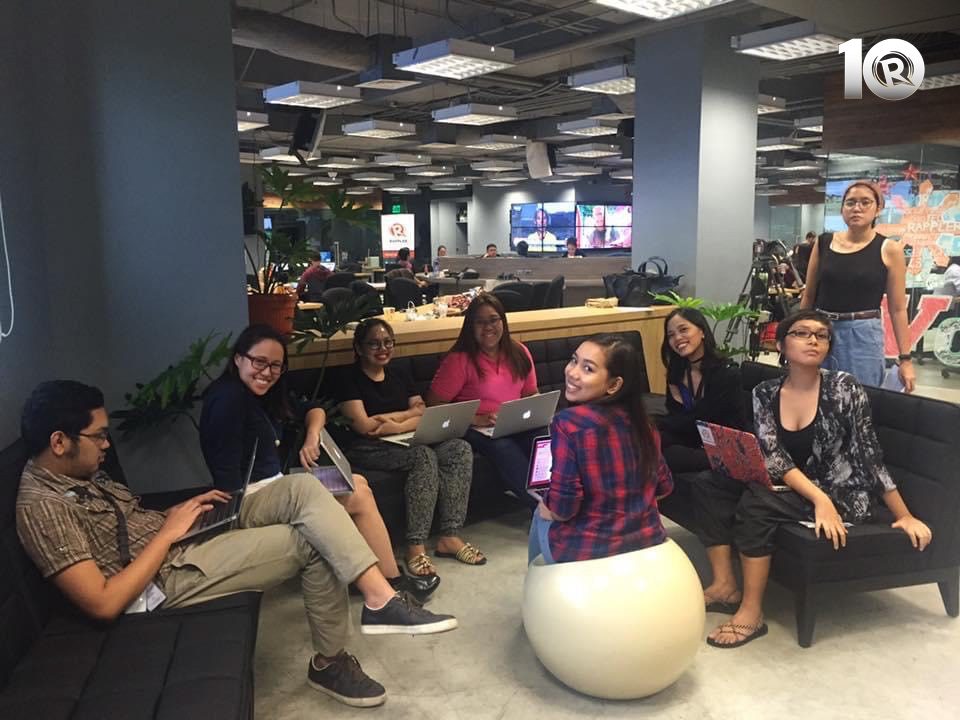SUMMARY
This is AI generated summarization, which may have errors. For context, always refer to the full article.

I was with a bigger newsroom when I received the offer to work for Rappler in 2012. It wasn’t easy. Rappler was barely two months old then; nobody knew what it was.
I remember being at work in my old job when a one-month old news organization called Move.PH (the precursor to Rappler) was able to get an exclusive footage of ex-president Gloria Macapagal Arroyo while on hospital arrest at the Veterans Memorial Medical Center in Quezon City. “Paano sila nakakuha ng exclusive?” (How were they able to get an exclusive?) screamed a news producer, throwing my former newsroom into a frantic chase to get one as well.
That was the first time I heard of this little organization. A month later, I joined it, leaving a secure job and embracing uncertainty. I took the job because the pay was fair, and I was excited about the idea of having a bigger stake in operations and helping build an organization from scratch.

I spent seven years of my life with Rappler from 2012-2019. Mentorship was taken seriously so early on, I was taught the importance of accountability. I was also pleasantly surprised about how much trust our seniors gave us to experiment and make mistakes (and oh boy did we!). With this privilege, we were encouraged to be transparent about our mistakes, own up to them, learn from them, and move on quickly. These were among the best lessons I learned from Rappler, which became a major guiding principle in everything I did moving forward, not just for the organization but for myself.
Building relationships
As part of Rappler’s social media team (now digital communications team), I was tasked to figure out how to reach more people and how best to deliver the news to the public using our social media accounts. About two years later, in 2014, I was promoted as head of the team.
We attempted to personify a news account with the aim of building relationships with our followers and giving the news a more interesting appeal. For instance, a new business controversy would be explained on a live ask-me-anything chat with our followers by our resident business expert; universities had their own chibi icons for when we delivered university sports and some campus-related reports; our papal visit coverage would collect what our followers would like to show the Pope, which was printed in a book and handed to Pope Francis himself; and our election coverage would guide our followers to focus on issues instead of the politicians by personifying and gamifying the policy questions at hand.

We were determined to be innovative and comprehensive in every special coverage, and Rappler readers and followers were always the key element in all our innovation. I remember so many milestones: a 2013 senatorial debate streamed live with real-time questions and reactions from viewers; crowdsourced election-related incident reports mapped live; the first Facebook live Q&A and production of the first Facebook live presidential debate in the Philippines; and a Twitter partnership for the launch of presidential candidates emojis, to name a few.
Rappler labels
It was during the 2016 presidential elections when Rappler was called “pro-Duterte” probably because of the early and colorful one-on-one interviews with then-Davao mayor Rodrigo Duterte, the multiple feature stories about him as a relatable regular man, his solo appearance on Rappler’s the #TheLeaderIWant presidential debate, which was the first presidential debate to be aired live on Facebook, and our multiple reports of him winning all of Rappler’s SMS and online polls.
Everything changed after Duterte became president when he wolf-whistled a female reporter, and it was a Rappler reporter who did her job and questioned him about it. From being the so-called darling of his supporters, Rappler became the enemy in a snap. Not so much yet as “anti-Duterte,” just called “bastos” (disrespectful) for having the audacity, they said, to question the President on the wolf-whistling issue.
After Rappler reported Senator Bong Go’s links to a questionable frigates deal, the bigger networks of Duterte’s social media army began tagging us “anti-Duterte,” with no less than the President himself branding us “fake news” at a press conference. It was an echo of the narrative started by several propaganda machines against Rappler a year before.
Not isolated
Before 2016, I had lived through Rappler being called anti-Binay, pro-Binay, anti-Aquino, pro-Aquino, and anti-Roxas (oddly enough, Rappler was never tagged pro-Roxas at all), so as the head of the social media team, I was naive to think that the labels needed little-to-no attention and would keep changing over time like it always did. I was wrong.
We learned the hard way that the social media space has radically changed, and has become more toxic for journalists. A lot of the Rappler staff began to get attacks and threats online and knew we had to protect our journalists from any intimidation. We adjusted our workflows to include preparations for aggressive attacks after every critical report about the government and the spread of disinformation online. We were determined to not be silenced and regain focus on delivering uncompromised journalism.
It was not long after when the Securities and Exchange Commission issued an order revoking Rappler’s license to operate (which Rappler has appealed and which remains pending in court), and a fleet of other legal and extra-legal attacks against us came surging.
One attack after another
Honestly, from 2016 to 2019, it felt like no one in Rappler could get a break. It was one big attack after another and unfortunately, our focus was diverted from innovating and maintaining relationships with our followers to managing every crisis.
In 2018, more media organizations and individuals who expressed dissent shared the brunt of the attacks with Rappler. For what? For simply doing their job.

What was instilled in us is the belief that this fight wasn’t just about Rappler. Rappler’s active fight against disinformation is about protecting everyone’s freedom of speech and expression. It is about building a culture of working together to solve the biggest issues that the country faces through our civic engagement arm MovePH, and re-building a culture of open-mindedness and respect as well as talking again about the importance of facts and how to find them.
I left Rappler as the Head of Community-MovePH and Digital Communications at a tough time not because I wanted a way out, but because of personal reasons (and if you must pry, I married and I’m currently living abroad). I remember Rappler fondly and when I think back, it’s not the bad times and the hard-at-work moments that stand out but the memory of working and evolving together as a team.
Rappler is not one person, it is every single team member driven by the company’s mission to deliver uncompromised journalism. And I don’t know what can be more revolutionary than Maria Ressa receiving a Nobel Peace Prize. It just makes one more hopeful for the next 10 years for Rappler, doesn’t it? – Rappler.com
Stacy operates a marketing business and as of writing resides in the UK.
Add a comment
How does this make you feel?


![[OPINION] You don’t always need a journalism degree to be a journalist](https://www.rappler.com/tachyon/2024/06/jed-harme-fellowship-essay-june-19-2024.jpg?resize=257%2C257&crop=287px%2C0px%2C720px%2C720px)














There are no comments yet. Add your comment to start the conversation.